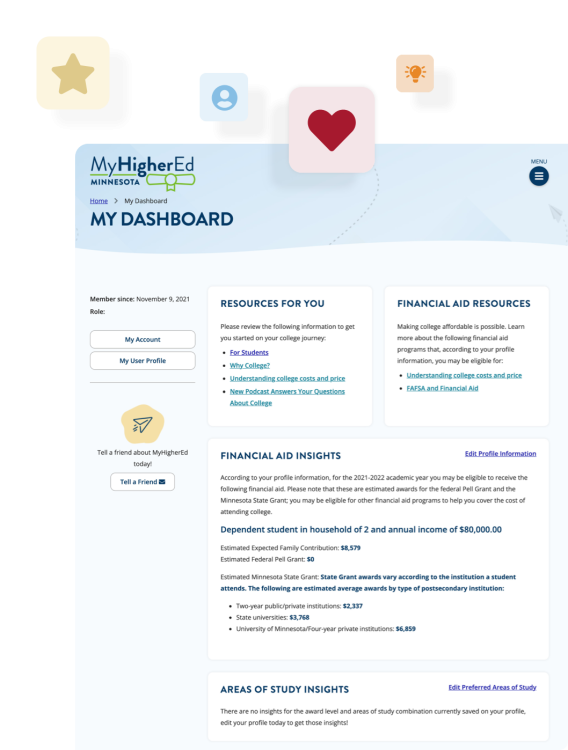Enrolling in a credential- or degree-granting college or university can open exciting opportunities. It can offer your child new life experiences, as well as a chance to expand his or her personal and professional connections. The process of finding the right institution and applying can be confusing and stressful, even for those who have gone through the process. So, it’s no surprise that during your kid’s junior and senior years, when their life is becoming increasingly hectic, they may depend on you to help and support them with this complex process.
Search For the Right Fit
Understanding what kind of college experience your kid is looking for and is comfortable with can be useful when starting your college exploration with them. Look for an institution and program that best fits with your child’s personal, educational, and professional goals. Here you will find some considerations to be aware of. Maybe your kid already has a few colleges in mind, but can't decide which one is the best fit for them. In that case, you can jump directly to our College Search Tool to explore Minnesota institutions. The tool allows you to compare school profiles by cost, size, financial aid available, admission requirements, programs, and graduate outcomes.
Find a College
Explore and compare among all Minnesota postsecondary institutions.
Narrow the focus
Minnesota has nearly 200 colleges and universities that vary in size, student support services and extracurriculars. Here are a few considerations to keep in mind as your child and you search for a college that meets their needs.
Type of Institution
While there is no magic formula for choosing a college, one way to narrow down the list is to start by asking some questions. For instance, does your child prefer to attend a two-year college or four-year university, and does he or she have a preference of whether the institution is public or private?
- Public two-year colleges: These institutions accept all students with a high school diploma or GED and offer a variety of educational options. Students can earn a credential focusing on a specific occupation, or can take up to the first two-years of courses to complete a bachelor's degree upon transfer to a four-year university. Additionally, some colleges offer opportunities to participate in athletics, clubs, activities, and music or the arts.
- Public four-year universities: Minnesota State and the University of Minnesota offer a wide variety of undergraduate, graduate and professional degree programs. Most offer a wide range of athletics and intramural sports as well as programs in theater, music and the arts. Undergraduate on-campus housing is also available on most campuses.
- Private for-profit career colleges: They offer programs focusing on specific careers. Some colleges focus on one specific career, such as cosmetology schools, while others offer several career programs. Programs generally range from a few months to two years.
- Private four-year private colleges: Most of private universities in Minnesota are liberal arts colleges, which emphasize broad knowledge in the arts, sciences, social sciences and humanities. Many are affiliated with a religious denomination. Some colleges only focus on students wishing to receive a bachelor's degree, while others only offer graduate training or a combination of both.
Geographic Location
Location, location, location. It’s often associated with buying and selling real estate, but it is just as important when choosing a college. Minnesota residents can benefit from in-state tuition or the state’s tuition reciprocity program with neighboring states. Some students choose to attend college near their hometown, allowing them to save money by living at home, as well as cut costs on travel, since car rides are usually less expensive than airfare.
Your child may also want to consider whether he or she prefers living in a rural area, city, or some place in between. Small college towns typically have an intimate sense of community, whereas schools in large cities can offer more access to internships with large companies and nonprofits.
School Size
Minnesota colleges and universities come in all sizes, from small liberal arts colleges with fewer than 1,000 students to large universities that annually enroll more than 30,000 students.
Large universities can offer a wide variety of majors and courses, housing options and activities. Additionally, large schools typically maintain well-stocked libraries, state-of-the-art research facilities, and nationally recognized sports teams. Notably, introductory classes can be large, which some students find exciting while others find overwhelming.
On the other hand, small schools may not offer as many programs as large universities, but they often provide specialized degrees and lots of hands-on learning opportunities. Small colleges can also mean smaller class sizes, allowing your student to easily access individualized support from faculty and staff.
Overall Cost
Costs vary from school to school, and there are five main categories of expenses you’ll want to keep in mind: tuition and fees, room and board, books and supplies, personal expenses, and transportation.
It’s recommended that you look beyond published tuition prices, since what is listed may not be the actual amount you and/or your child pay after financial aid and institutional grants. Consider colleges that not only offer affordable tuition but also substantial financial aid packages, which may include grants, scholarships, loans and work-study opportunities.
Online Education
More and more institutions are offering programs using the Internet. Online opportunities may provide your student with the option of learning in flexible, convenient and personalized formats. The quality of online education can be excellent, providing students with experiences, exercises and assessments that rival the traditional classroom.
However, it’s important to be aware that the Internet also offers new ways for educational scams and diploma mills to reach out to people who are looking for genuine education. It is not always easy to identify phony operations from a casual look. Most of the questions you should ask any school before enrolling also apply to online education.
Finally, choosing a college that is a right fit involves many considerations. For many academic quality, location, cost and size are all significant factors. However, there are also other areas to consider, including:
- Campus environment and activities
- Available health and mental health services
- Accommodations for special needs
- Diversity of student population
- Faculty experience and expertise
- Length of time and location of classes
- Graduation statistics for that institution
- Academic reputation and credibility
- Tutoring and academic support services
- Transportation availability and cost
- Campus safety
With that information in mind, read the Choosing A College guide or explore the College Search Tool to discover what Minnesota colleges and universities have to offer and find programs that will help your child meet their goals.
Direct Admissions Minnesota
The Direct Admissions program notifies graduating high school seniors from participating Minnesota high schools of the Minnesota colleges and universities that are eager to admit them based on their academic records and their projected graduation date. Students then can apply with confidence knowing that their admission has been granted already.
How Does Direct Admissions Work?
Early in the school year, seniors at participating high schools who are on track to graduate receive a personalized communication, co-signed by their high school and the Minnesota Office of Higher Education, that lists all participating Minnesota colleges and universities they are proactively admitted to. If your kid receives this notification, make sure they submit an admissions application (free) for each of the colleges and universities they are interested in attending, within the application deadline for each institution.
Some schools may require additional materials, such as essays and standardized test scores. If your child is participating in this program, make sure to research each institution they are applying to, visit the institutions’ website and/or campus, look into majors and programs, and consider tuition costs and financial aid options. Applications are processed according to the timeline indicated by each college or university’s website. Finally, your kid should receive an official acceptance letter after they have submitted their application.
There are over 50 Minnesota colleges and universities participating in the Direct Admissions program, including a full range of community, technical, tribal, public and private institutions. Click here for a full list of participating colleges and universities. Students interested in postsecondary institutions that are not in their personalized list should follow the standard application process for each schools.
Applying to More Than One School
Your kid may have a first-choice school in mind, but it’s recommended that they apply to more than one college. This will not only give them a greater chance of acceptance, but could also offer more options and opportunities.
There is no correct number of schools to apply to, and will vary depending on each person’s personal situation and priorities. Some students apply to a range of schools, from their aspirational selective colleges to those that are considered a “safety” option, or a school that offers them guaranteed acceptance. On the other hand, given the cost and time that’s required to apply to each college, it may be advisable that your kid applies to only a few schools that will meet their needs, while ensuring acceptance.
Help Them Choose Their Path
In this post we offer tips to narrowing down options according to career and educational goals.
Help your kid be prepared
Depending on the institution, applying for college may require your kid to take care of the following:
Find out if admissions exams are required
Most four-year colleges or universities require students to submit ACT or SAT scores. If you child applies to a school with open enrollment, he or she may not need to take the ACT or SAT. Otherwise, make sure they are aware of the test dates, times and locations. School counselors area good resource to find out test dates, times, and how to sign up for them.
Plan campus visits
Once your child’s career interests and priorities have been identified, and institutions have been researched and explored, a good way to narrow down a list of six or seven schools is by visiting college campuses.
Visiting the campus is the best way to learn about a school. It offers the opportunity to see the professors and students in action, use and explore the facilities, and get a feel for what college life would be like at that school. While campus visits aren't necessary, they are highly recommended, and most colleges have organized visit programs.
While on a campus visit, your child should:
- Pay attention to equipment and school facilities.
- Sit in on a class or two.
- Talk with current students in the program.
- Talk with instructors in the program.
- Talk with an admissions counselor.
- Talk with a financial aid counselor.
Reach out to the Admissions Office
There are many important questions that will need to be answered as your child enters the application and college admissions process. One of the best ways to get those answers is by reaching out to prospective university’s admissions office.
Some common questions include:
- How much does it cost to attend this college (including tuition, room and board, fees, etc.)?
- What financial aid options are available?
- Does the school participate in federal and state aid programs?
- What percentage of undergraduates receive aid? How much do they receive on average?
- Which financial aid forms do you need to fill out and what are the deadlines?
- Does the college offer any financial aid of its own? If so, how do you apply?
- Will private/non-government scholarships reduce the amount of need-based aid you receive?
- How is financial aid paid out? When will it be received?
Collect high school transcripts
Most colleges will require a copy of your child’s high school transcript. You can request this be sent to the college(s) he or she is interested in through the high school's office or the school counselor.
Be aware of application fees
It is common for colleges and universities to charge an application fee (anywhere from $20-$75). If you can't afford it, talk to an admissions counselor at the college to which your child is applying. You may be able to get the fee waived.
Request for Letters of recommendation
Four-year colleges or universities often require letters of recommendation. These recommendations are about what you student has accomplished, what kind of potential he or she has, and why the person writing the letter believes he or she should be admitted to that college. Recommendation can come from teachers, coaches, mentors, church leaders, employers and people your child has worked with in your community. Recommendation cannot come from relatives.
Write a compelling essay
Many students who attend a four-year college or universities will need to write an application essay. If the essay topic isn't provided, your child can choose their own, or they can reach out to a school counselor, teacher or you to provide guidance and insight on what may constitute a good essay topic.
Often, the essay is an opportunity for applicants to highlight their passions, work ethic and writing skills or to explain academic low-points. It’s recommended they avoid reiterating information that can be found elsewhere in the application, listing accomplishments without elaborating and being overly wordy.
Schedule and prepare for interviews, if required
If the school is very selective with its admissions process, a student may have to schedule an interview. The best interview tip is for students to relax and be themselves.
Other recommendations for a college admissions interview include dressing well, answering all questions truthfully, being prepared with a list of proudest accomplishments, asking questions and sharing why this is the college for them.




